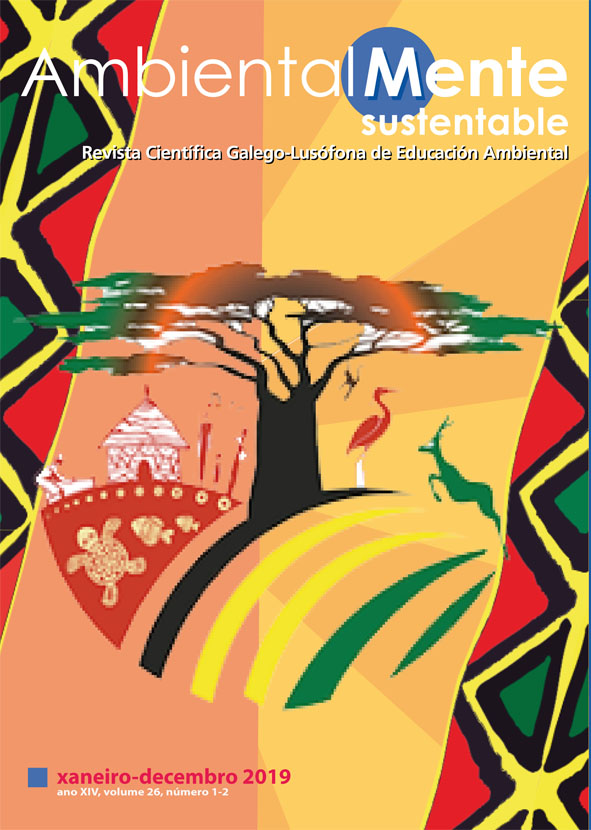Implementation and consolidation of equipment for environmental education
Considerations on strategies to be outlined and adopted
DOI:
https://doi.org/10.17979/ams.2019.26.1-2.6548Keywords:
territorial equity, facilities for environmental education, continental Portugal, low density territory, sustainabilityAbstract
Facilities for Environmental Education (EqEA) has the potential of being an effective social facilitator, whilst stimulating a sustainable community development. The present paper aims to promote “Facilities for Environmental Education”, a book that through site visits and surveys, alongside the professional photography of António Borba and the modern and elegant design of Luís Gabriel, unveils sixteen EqEA located in the inner northern and central continental Portuguese regions. The work targets a wide audience comprised of environmental educators and EqEA managers, decision-makers, entrepreneurs and potential equipment’s visitors/users. It intends to contribute towards an urgent reflection and discussion about the role of this environmental education resource – the EqEA – both in the present day and near future, in light of the current National Strategy for Environmental Education of Portugal. A result from the “Facilities for environmental education for a sustainable new Earth culture” project, which combined the efforts of the universities of Trás-os-Montes and Alto Douro (Portugal), São Paulo (Brazil) and A Coruña (Galicia), this book points out guidelines, challenges and opportunities that can foster a fairer socio-environmental experience and underlines the need for an EqEA network to be developed, if territorial equity is to be achieved, especially in low density territories.
Downloads
References
APA–Agência Portuguesa do Ambiente, I.P. (2017). SNIAmb–Sistema Nacional de Informação de Ambiente, Agência Portuguesa do Ambiente, I.P. http://www.apambiente.pt/index.php?ref=16&subref=142&sub2ref=698; http://sniamb.apambiente.pt [Acedido em setembro de 2017].
Correia Marques, Margarida, Araceli Serantes, Fátima Marques, Marcos Sorrentino, Maria Inês Vicente, Pedro Russo e Sara Carvalho. (2018). Equipamentos para a educação ambiental. Um caminho de sustentabilidade no interior Norte e Centro de Portugal Continental. Vila Real: UTAD- Universidade de Trás-os-Montes e Alto Douro.
Correia Marques, Margarida, Fabiola Hipólito e Rosanno Bastos (2017). “Os equipamentos de educação ambiental para a sustentabilidade no cerne do Entre-Norte-e-Centro”, AmbientalMente Sustentable. Revista Científica Galego-Lusófona de Educación Ambiental, XII, 23-24 (1-2), páj. 119-139.
Correia Marques, Margarida, A. Martins, A. Mascarenhas, A.P. Silva, A.C. Rodrigues, C. Rodrigues, C. SÁ, F. Hipólito, F. Marques, I. Branco, J. Baptista, J. Jorge, J. Aranha, N. Barros, O. Santana, S. Lobo, S. Mesquita, S. Leite, e V. Seixas (2015): Sete concelhos, um território: uma caraterização ambiental e socioeconómica no cerne do Entre-Norte-e-Centro. Cascais: Princípia.
Resolução do Conselho de Ministros n.º 100/2017 de 11 de julho. Estratégia Nacional de Educação Ambiental em Diário da República, 1.ª série, n.º 132, 3533-3550.
UN–United Nations (2019). Sustainable Development Goals. [Acedido em julho de 2019: https://www.un.org/sustainabledevelopment/sustainable-development-goals].
Downloads
Published
How to Cite
Issue
Section
License
The papers published in this journal are licensed under a Creative Commons Attribution-ShareAlike 4.0 International License.
Authors grant the right of first publication to the ambientalMENTEsustentable, which may publish in any language and format as well as publish and distribute their whole or partial content by any technologically available means and via data base.
Authors are allowed and encouraged to disseminate the articles accepted for publication on personal or institutional websites, before and after their publication, provided it is clearly stated that the work belongs to this journal and all bibliographic data are provided along with access to the document.



